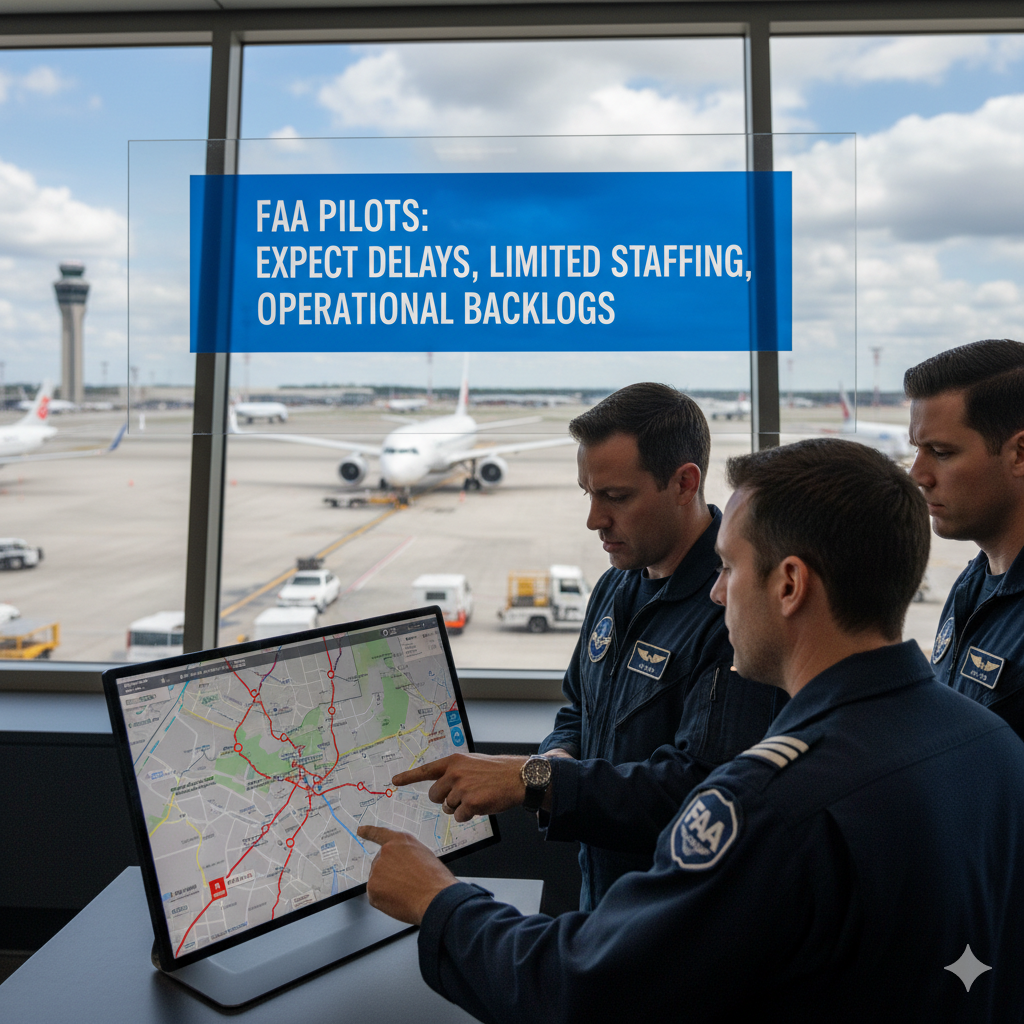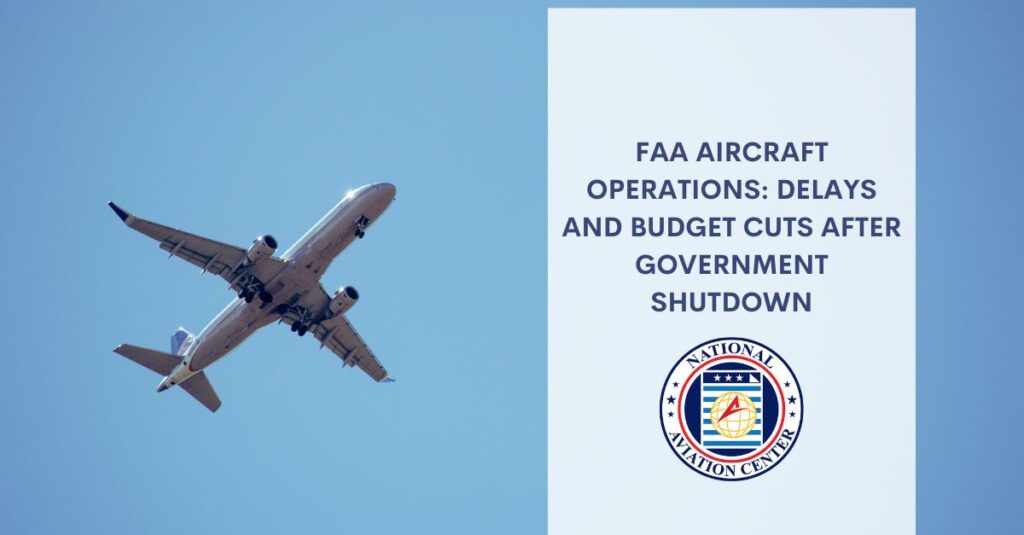With staffing shortages and budget constraints mounting, the Federal Aviation Administration (FAA) has implemented mandated flight reductions and postponed program activities. For us here at the National Aviation Center, see this as a call to action as we support operators, FAA aircraft owners, pilots and registrants who rely on seamless, reliable aviation infrastructure.

FAA Aircraft Cuts and Delays in Context
According to Forbes and other sources, the FAA has directed airlines to reduce domestic scheduled operations at 40 major U.S. airports by up to 10 percent between 6 a.m. and 10 p.m. local time, as part of its response to front-line staffing shortfalls amid the shutdown.
These reductions began at approximately 4 percent and escalated as the federal impasse continued.
In parallel, cargo operations are increasingly strained. Regulatory and certification delays tied to the FAA’s oversight responsibilities mean that even after operations resume, recovery will not be instantaneous.
In short:
- Capacity is being intentionally limited to reduce risk in an understaffed environment.
- Cargo pipelines and freight-in-passenger-bellies are under pressure as non-commercial operations absorb capacity.
- The ramp-up to normal operations will span days or weeks, not hours.
What This Means for Travelers
For individuals booking flights or planning travel, the implications are immediate:
- Expect higher chances of delays and cancellations, especially for domestic routes at hub airports.
- Some airlines are prioritizing hub-to-hub or long-haul international flights, drawing down regional or non-core offerings.
- Rebooking may become more difficult; it is wise to check status frequently and consider buffer time when scheduling connections.
- Even once the shutdown ends, travel schedules won’t snap back to “normal” overnight—the FAA and carriers both note a gradual recovery.
While we here at the National Aviation Center cannot change that, we can help you navigate aviation services (like filing for an aircraft mortgage, and so forth) with awareness of these trends. That way, your aviation aligns with current operational realities.
What FAA Aircraft Pilots Should Know
From the cockpit, the story is no less complex. If you’re a pilot operating under the FAA’s jurisdiction, these are key considerations:
- Air traffic control staffing shortages mean you may encounter longer holds, re-routing or fewer available slots at high-volume airports.
- Flight planning should include contingency time, and you should coordinate ahead with dispatch or scheduling if you’re flying into a hub during peak hours.
- For private operations at smaller fields, ground-based services (airport tower, approach control) may be stretched, so plan your communications and taxi/runway operations accordingly.
- Even after budget deals get resolved, the backlog of deferred hiring, training and certification means that normal service levels may lag—so plan conservatively.
We provide registration and aircraft re-registration support at the National Aviation Center to help you stay aligned with these shifting operational parameters.

What This Means for FAA Aircraft Owners and Registrants
If you’ve registered aircraft or are considering that step, the changing FAA landscape matters.
First, for the owners of aircraft who are e updating an aircraft’s status, performing an aircraft change of address, dealing with liens or mortgages, or filing for a plane exchange of ownership, we offer rush processing services that can help.
Why the Budget Cut and Staffing Shortfall Are Significant
It’s not just the immediate flight cuts—instead, it’s the broader degradation of aviation infrastructure that matters. Furthermore, the shutdown has forced air-traffic controllers and other essential aviation personnel to work without pay, leading to higher absenteeism and fatigue.
Budget constraints affect:
- Hiring and training of new controllers and inspectors.
- Maintenance of certification programs and oversight activities.
- Modeled safety margins and reserve capacity that underpin aviation reliability.
- Certification and auditing of cargo operations and new entrants.
This means the system is operating with less cushion. At the National Aviation Center, we stress that aviation professionals and aircraft owners alike must adapt—plan for lower margins of error, allow extra time, and seek support when navigating regulatory processes.
How We Support You
At the National Aviation Center we offer specialized services tailored to help you through this environment:
- Assistance with FAA registration forms, updates and tracking of status.
- Guidance on aircraft change of address filings, lien records and aircraft abstract of title retrievals.
- Support for owners executing plane exchange of ownership including due-diligence and regulatory filings.
- Advisory for pilots on operational impacts resulting from FAA capacity and staffing changes.
- Personalized consultation for aircraft owners concerning potential compliance delays and best practices during agency slowdowns.
By partnering with us, you gain access to experienced aviation-industry support focused on administrative clarity and regulatory alignment—especially important when the aviation ecosystem is under stress.
What You Can Do Right Now
- If you have upcoming travel: monitor flight status, plan for extra time or alternate routing, and factor in possible delays when making connections. Proactive coordination now helps avoid last-minute surprises when the system is stretched.
- If you’re a pilot: schedule pre-flight briefings that account for potential ATC staffing impacts; maintain flexible alternatives.
- If you own or register aircraft: file early, ensure your paperwork is complete and correct, and avail yourself of rush processing when necessary. .
The National Aviation Center stands ready to assist you through each of these steps.
Help With FAA Aircraft Registration Today and Tomorrow
The disruption to FAA aircraft operations resulting from the budget and staffing crisis is serious and not confined to airlines alone. Travelers, pilots and aircraft owners all face tangible effects. With the right support and awareness, you can manage through this period with greater confidence and fewer surprises. At the National Aviation Center, we are committed to helping you navigate this evolving aviation landscape.




